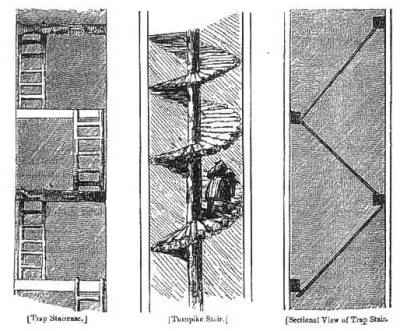Stair and Ladder Pits
This method of bringing coal to the surface, was common in the east of Scotland, particularly in edge seams. Coalbearers carried their very heavy loads of coal up a series of stairs or ladders. They were easily constructed and had no running costs unlike horse gins.
These illustrations from the 1842 Franks Report show two types of stair pit.
A 'Trap Staircase' and a 'Turnpike Stair'.

Description of a coalbearer bringing coal up a ladder pit
The Franks Report gives an detailed description of the work of Ellison Jack, an 11 year old coalbearer in a ladder pit at Loanhead. In this pit the coal was not carried directly to the surface, but only to the foot of a shaft where it was raised above ground probably by a horse gin.
"[...She has to descend a nine-ladder pit to the first rest, even to which a shaft is sunk, to draw up the baskets or tubs of coals filled by the bearers; she then takes her creel (a basket formed to the back, not unlike a cockle-shell, flattened towards the neck, so as to allow lumps of coal to rest on the back of the neck and shoulders) and pursues her journey to the wall-face, or as it is called here, the room of work. She then lays down her basket, into which the coal is rolled and it is frequently more than one man can do to lift the burden on her back. The tugs or straps are placed over the forehead and the body bent in a semicircular form, in order to stiffen the arch. Large lumps of coal are then placed on the neck and she then commences her journey with her burden to the pit bottom, first hanging her lamp to the cloth crossing her head. In this girl's case she has first to travel about 14 fathoms (84 feet) from wall-face to the first ladder, which is 18 feet high: leaving the first ladder she proceeds along the main road, probably 3 feet 6 inches to 4 feet 6 inches high, to the second ladder, 18 feet high, so on to the third and fourth ladders, till she reaches the pit-bottom, where she casts her load, varying from 1 cwt to 1.5 cwt., into the tub. This one journey is designated a rake; the height ascended and the distance along the roads added together, exceed the height of St. Paul's Cathedral; and it not unfrequently happens that the tugs break and the load falls upon those females who are following. However incredible it may appear, yet I have taken the evidence of fathers who have ruptured themselves from straining to lift coal on their children's backs.]"